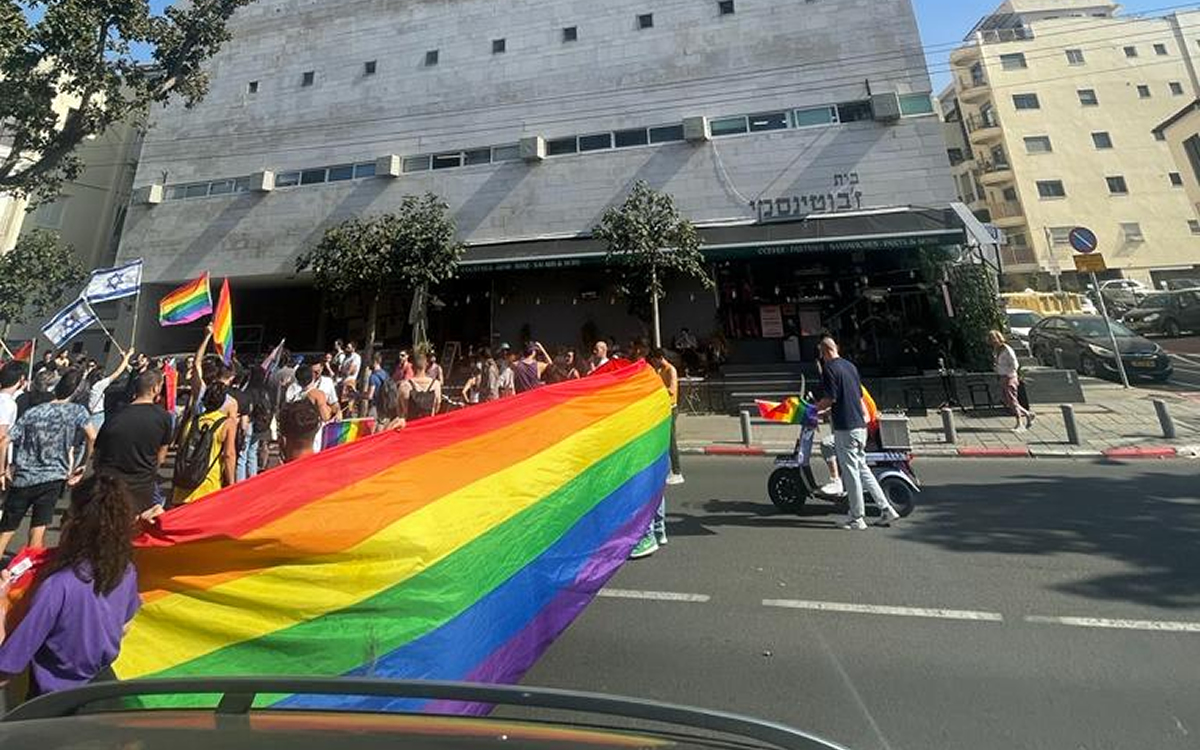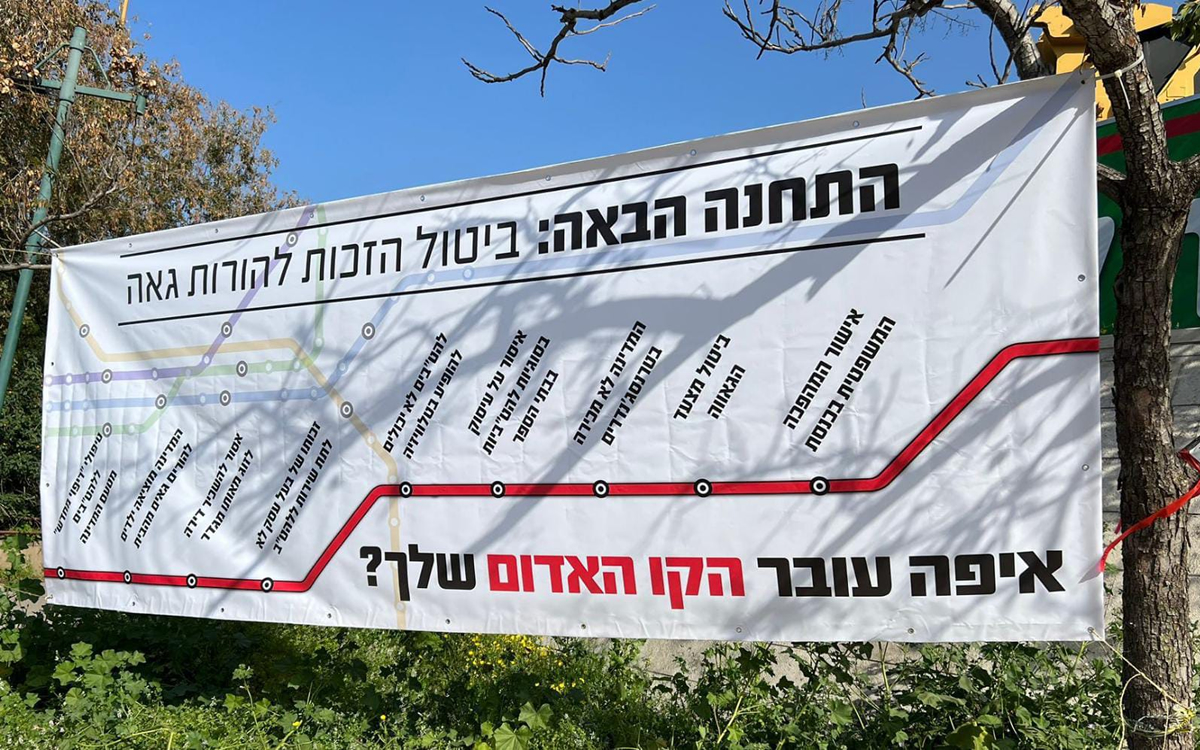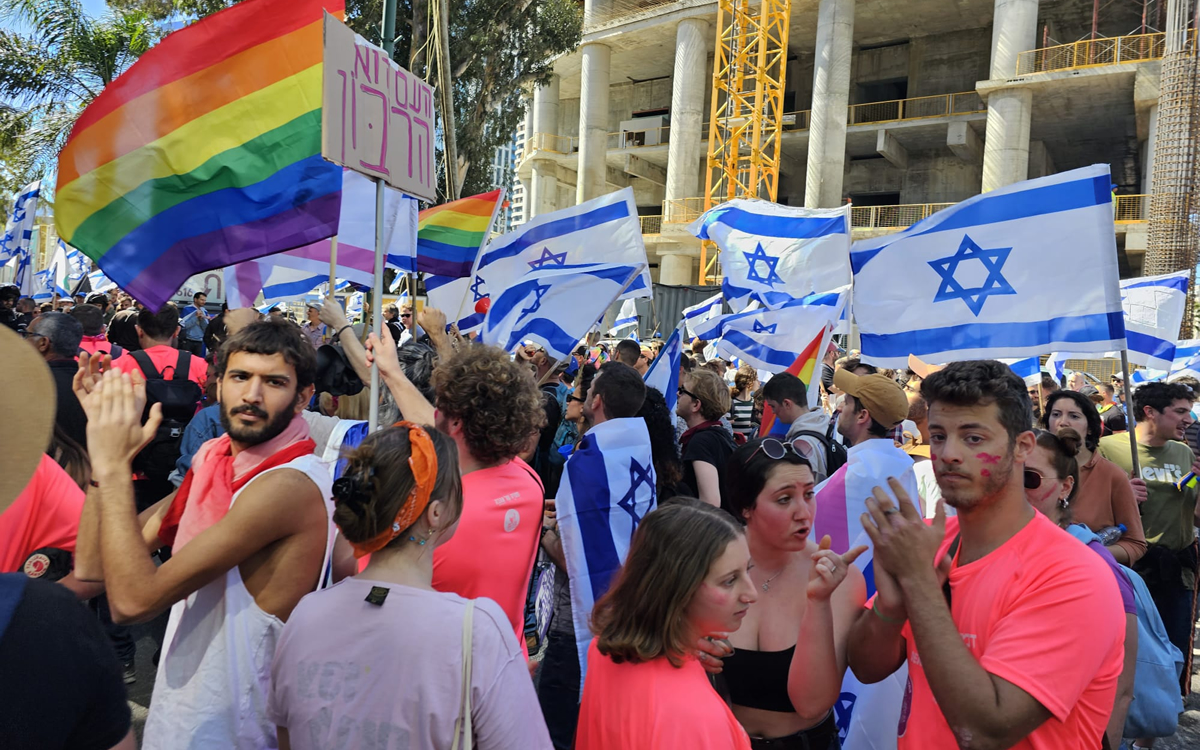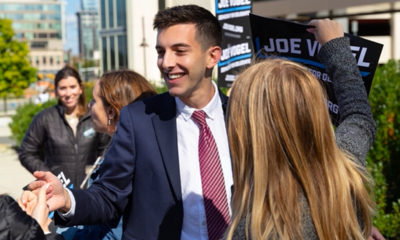Opinions
Silence and complacency are not an option for Israel’s LGBTQ community
Proposed reforms of country’s judiciary have sparked widespread protests

WDG is the Washington Blade’s media partner in Israel.
Thursday was another record day for the protests against the legal revolution that members of Prime Minister Benjamin Netanyahu’s government are trying to carry out. High-tech employees and business owners, doctors and nurses, professors, teachers and students, economists and intellectuals, parents and children, security personnel and activists have united in the protest movement and the number of weekly demonstrations against the coup d’état have increased.
What began as a single demonstration in Tel Aviv 10 weeks ago turned into a huge demonstration of about 300,000 people in front of the Knesset in Jerusalem about a month ago. This movement two weeks ago turned into a Day of Disruption throughout the country and reached its peak on Thursday with the declaration of a National Day of Resistance.
LGBTQ and intersex people and organizations have joined the struggle.
LGBTQ and intersex organizations on Thursday morning held their own protest in Tel Aviv’s Culture Square before they marched with Israeli and Pride flags and joined other protest groups in front of the city’s government building.
These organizations took part in the first demonstrations that took place more than two months ago. They formed a larger LGBTQ group and marched together as one, with gay party promoters joining them later. The Aguda, Hoshan, IGY (Israel Gay Youth), the Gila Project and Maavarim rented buses for LGBTQ and intersex people who wanted to go to Jerusalem and demonstrate in the capital.
Next step: Cancelling the right to LGBTQ parenthood
One of the largest protests to date is the Day of Disruption that took place on March 1.
The day, which began as protests that took place in dozens of cities across Israel as MKs passed bills, for the first time during the protest movement saw violent scenes between protesters and police officers, who used stun grenades to disperse them.
The Aguda and Hoshan before the Day of Disruption hung signs in the train stations that simulated a train route. Bills that would discriminate against the LGBTQ and intersex community and simulating life after the legal revolution’s approval in the Knesset were written in place of station name: The first stop was the cancellation of Pride parades, followed by the cancellation of transgender pregnancies, a ban on discussing LGBTQ and intersex issues in schools and in the media, repealing the discrimination ban removing children from same-sex households and approving so-called conversion therapy.
“The State of Israel is speeding down a path of direct discrimination, and that is our red line. When the first stop is crushing the justice system, the next stops are canceling the right to gay parenthood and allowing discrimination in businesses, just like what happened in Hungary and Poland,” wrote the Aguda and Hoshan in their campaign. “This is exactly the time for everyone to ask themselves where his red line cross — because when the legal revolution leaves the station, it will be very difficult to stop the violation of the rights we fought for years.”

Lesbians on motorcycles at the beginning of the Day of Disruption blocked traffic throughout Ramat Gan and Tel Aviv while on their way to Jerusalem. The Israeli “Pride and Ride” Dykes on Bykes movement led the protest. Dykes on Bykes has existed since 1976, and has emerged as a significant part of the country’s LGBTQ and intersex rights movement and as a symbol of female strength and Pride for every lesbian woman.
At the same time in Jerusalem, writer Ilan Scheinfeld arrived at the Western Wall plaza with his two sons who were born by surrogacy and waved a large pride flag in front of the Western Wall.
Israel’s LGBTQ and intersex families have launched a campaign aimed at Knesset Speaker Amir Ohana, a proud father of twins, in which they tried to appeal to his heart as a gay person who started a family thanks to Supreme Court rulings, and to explain to him what the consequences of a political revolution might be on gay parenting.
Aguda Chair Hila Peer in the evening spoke at the central demonstration in Tel Aviv.
“They think they will push us back into closets. This government has a clear agenda and the LGBTQ community is one of the first in line. This is not legal reform, it is a gun that is being held to the head of the LGBTQ community. They are destroying the only body that protects human rights, so that later they can enact whatever they want against us,” said Peer. “This government has brought up the worst haters of freedom, of equality and of the LGBTQ community, It gave them power over our families, over our rights. We faced crazier, meaner, more violent and broke every closet they ever dared to try build for us.”
“The year is 2023 and we are going nowhere but forward,” added Peer. “Even if you take the court, even if you threaten us in the streets. Even if you deny us right after right, we will not stop. We will not disappear. The LGBTQ community was born out of a revolution, and the LGBTQ community will bring the next revolution.”

Opposition community representatives also tried to disrupt the Constitution Committee’s proceedings, or at least create actions that would cause them to become illegitimate. MK Yorai Lahav Hertzno from Yesh Atid party during one of the debates came up to the table and began chanting “shame” while pointing an accusing finger at MK Simcha Rotman, who chairs the committee The demonstration caused a lot of criticism and the Knesset’s Ethics Committee punished Hertzno.
Why is the LGBTQ and intersex community afraid?
The absolute majority of the rights of the LGBTQ and intersex community in Israel today came from Supreme Court rulings. From treatments for HIV carriers to surrogacy and parentage registration, all achievements were achieved as a result of battles waged in court against the decisions of the government and the Knesset.
The regime change that includes the weakening of the Supreme Court’s power and allows the Knesset to overrule any Supreme Court ruling with a simple majority allows the cancellation of any Supreme Court decision with relative ease. Although laws against the LGBTQ and intersex community are not currently on the agenda, the potential for change is clear such possibility.
If the legal revolution passes, the government will be able to enact laws that directly harm LGBTQ and intersex people — and without an independent court there will be no one to protect them or the rights we have already received.
Already now, under the auspices of the public atmosphere, there is an increase in the number of reports of cases of discrimination and violence against LGBTQ and intersex people in businesses and in the public sphere. This discrimination would be legal if some extreme MKs succeed in their efforts. LGBTQ-phobic members of Knesset are already spreading their dangerous agenda today and promote bills that will harm LGBTQ and intersex youth and the creation of safe spaces in schools.
The LGBTQ and intersex community and its rights are under attack, and LGBTQ and intersex people will be among the first groups to be harmed when the checks and balances are removed from the government. Silence and complacency are not an option for Israel’s LGBTQ and intersex community.
George Avni is the editor of WDG, an LGBTQ and intersex media outlet in Israel.

In 2023, the law was signed to expand the District’s medical cannabis program. It also made permanent provisions allowing residents ages 21 and older to self-certify as medical cannabis patients. Overall, cannabis is fully legal in D.C. for medical and recreational use, and 4/20 Day is widely celebrated.
Medical cannabis, for example, has a long history with the LGBTQ community, and they have often been one of the oldest supporters of marijuana and some of the most enthusiastic consumers. Cannabis use also has a long history of easing the pain of the LGBTQ community as relief from HIV symptoms and as a method of coping with rejection from society.
The cannabis culture continues to grow in the District, and as a result, so does the influence on younger people, even youth within the LGBTQ community. Drug education can play an important role and should not be avoided during 4/20 Day. Parents and educators can use drug education to help their kids understand the risks involved with using marijuana at a young age.
According to DC Health Matters, marijuana use among high school students has been on the decline in the District since 2017. In 2021, it was estimated that around 20% of high school students use marijuana, a drop from 33% in 2017. Nationally, in 2020, approximately 41.3% of sexual minority adults 18 and older reported past-year marijuana use, compared to 18.7% of the overall adult population.
When parents and educators engage with their kids about marijuana, consider keeping the conversations age appropriate. Speaking with a five-year-old is much different than speaking with a teenager. Use language and examples a child or teen would understand.
The goal is to educate them about the risks and dangers of using cannabis at a young age and what to avoid, such as edibles.
Most important, put yourself in your kid’s shoes. This can be especially important for teenagers as they face different social pressures and situations at school, with peer groups, or through social media. Make a point of understanding what they are up against.
When speaking to them about cannabis, stay calm and relaxed, stay positive, don’t lecture, and be clear and concise about boundaries without using scare tactics or threats.
Yet, it’s OK to set rules, guidelines, and expectations; create rules together as a family or class. Parents and educators can be clear about the consequences without lecturing but clearly stating what is expected regarding cannabis use.
Moreover, choose informal times to have conversations about cannabis and do not make a big thing about it. Yet, continue talking to them as they age, and let them know you are always there for them.
Finally, speak to them about peer pressure and talk with them about having an exit plan when they are offered marijuana. Peer pressure is powerful among youth, and having a plan to avoid drug use helps children and students make better choices. Ultimately, it is about assisting them in making good choices as they age.
Members of the LGBTQ community often enter treatment with more severe substance use disorders. Preventative measures involving drug education are effective in helping youth make good choices and learn about the risks.
Marcel Gemme is the founder of SUPE and has been helping people struggling with substance use for over 20 years. His work focuses on a threefold approach: education, prevention, and rehabilitation.
Opinions
Walking the pathway to national cannabis legalization
Social equity needs to be front and center in our efforts

As we gear up for a major election year, the buzz around cannabis legalization is getting louder. Policymakers are starting to see the need for comprehensive reform, while advocates and small business owners in the industry are cautiously optimistic about the future. But let’s not kid ourselves, this system was designed to keep certain communities out, and it’s crucial that we continue to address these deep-rooted inequities as we blaze the trail forward. A step toward legalization that doesn’t prioritize equity and dismantle the barriers that have held back marginalized groups would be a major bummer. In this op-ed, we’re going to take a groovy journey through the evolution of grassroots organizing in the cannabis industry and highlight the importance of social equity in achieving true national cannabis legalization and boosting our humanity along the way.
Over the years, I’ve been right in the thick of it, helping to build grassroots organizations like Supernova Woman and Equity Trade Network. These groups have been on the frontlines, fighting for cannabis programs in Oakland and San Francisco. I’ve also rocked my own brand, Gift of Doja, and organized the first Cannabis Garden at a major neighborhood street fair, Carnaval San Francisco. I even served as chair of the first Cannabis Oversight Committee in the nation. But the real magic has always happened in when working in coalitions. Each individual and organization brings a unique piece to the puzzle. Grassroots organizing is as challenging as crafting a democratic society but is worth the effort in generating workable implementable solutions. Collective efforts have been game-changers in shifting public opinion and paving the way for major policy changes at both the state and local levels.
As we navigate the path toward cannabis legalization, lobbyists and lawmakers can’t forget about the small business owners who have been grinding to build their dreams. Political advocacy and lobbying are important, but if we’re not uplifting the voices and experiences of those who have been fighting on the ground, we’re missing the mark. Big companies can hire lobbyists, but small business owners don’t have that luxury and if we are not in the room we are on the table. Coalitions allow for us to be in the room when we can’t physically be there. Our communities, especially people of color, have been hit hard by systemic oppression, from over-policing to mass incarceration and limited economic opportunities to limit our ability to be in the room of power and decision making.
Social equity needs to be front and center in any cannabis legalization efforts. It’s not enough to just remove criminal penalties or create a legal market. We need to actively work on repairing the damage caused by years of prohibition. That means fighting for resources, investment, and low-interest loans for small businesses. It means creating a tiered fee and tax structure that doesn’t crush the little guys. And it means opening up equity programs to all industries, not just cannabis. Social justice without economic access and repair is like a joint without a lighter – it just won’t spark the change we need. We have a responsibility to evolve the economy and break down unnecessary barriers. Activism, social justice, and economic reform are all connected, man.
Industry leaders, culture creators, advocates, and consumers alike, we all need to step up and promote social equity. It’s on us to support initiatives that provide resources, mentorship, and funding for individuals from affected communities to enter the legal cannabis market. And let’s not forget the power of our wallets. Buying from companies that align with our values and support the work we believe in can send a powerful message. Voting with our dollars might just be more impactful than showing up at the ballot box.
As we head into a major election year, the cannabis industry is at a crossroads. It’s a time for drumming up voter interest and for candidates to make promises that grassroots organizations have fought hard for. Small business owners will be navigating a tricky landscape, but we can’t lose sight of the power of collective work. By keeping social equity at the forefront, we can undo the harms of the past while building new frameworks that will shape a brighter future for all.
In conclusion, grassroots organizing has been the driving force behind shifting public perception and pushing for policy changes in the cannabis industry. But let’s not forget that true national cannabis legalization can only be achieved if we address social equity. It’s time for us to come together, listen to the voices of those most impacted, and walk the high road towards a future where cannabis legalization isn’t just about business opportunities, but also about healing and empowerment for all communities. Let’s light up a joint of social justice and blaze a trail towards a better tomorrow.
Nina Parks is co-founder of Equity Trade Network & Supernova Women. Reach her at [email protected].
Commentary
World ‘isn’t much different today’
The Nazis murdered nearly 1 million Jewish people at Auschwitz

OŚWIȨCIM, Poland — Łukasz, a Polish man who was our group’s English-speaking tour guide at Auschwitz, on April 7 asked us while we were standing outside one of Auschwitz I’s barracks why the Nazis systematically murdered more than 6 million Jewish people.
“Once they are gone, Germany will be great again,” he said, referring to the Nazis’s depraved justification.
There were other Americans in our group of about 40 people. I would like to think they are familiar with the dehumanizing MAGA rhetoric to which our country has become accustomed since President Joe Biden’s predecessor announced his White House bid in 2015. The fact that I was at a Nazi concentration camp was simply overwhelming, and I didn’t feel like speaking with them or to anyone else at that moment.
The unspeakable horrors that happened at Auschwitz are on full display. Łukasz’s comment was a stark warning to us all amid the backdrop of the current socio-political realities in which we in the U.S., Europe and elsewhere around the world currently live.
• Suitcases, glasses, shoes, kitchen utensils, prosthetic limbs, baskets, Jewish prayer shawls, and toothbrushes that were taken from people upon their arrival at Auschwitz were on display in Auschwitz I’s Block 5. One exhibit also contains children’s clothes.
• Auschwitz I’s Blocks 6 and 7 had pictures of male and female prisoners along the corridors. They contained their birthdays, the day they arrived at the camp and when they died. Block 7 also had mattresses and bunk beds on which prisoners slept and the sinks and latrines they used.
• The basement of Auschwitz I’s Block 11 had cells in which prisoners were placed in the dark and starved to death. The basement also had cells in which prisoners were forced to stand for long periods of time. Executions took place at the “Death Wall” in the courtyard between Block 10 and 11. Guards also tortured prisoners in this area.
• Medical experiments took place in Block 10.
• A gas chamber is located near Auschwitz I’s entrance with the gate that reads “Arbeit macht frei” or “Work sets you free.” The adjacent crematorium contains a replica of the furnaces used to burn human bodies.
• An urn with human ashes is in Auschwitz I’s Block 4. Hair cut from people who were killed in the gas chamber was also there.

Auschwitz I, a former Polish army barracks, is one of 40 camps and subcamps around Oświęcim, a town that is roughly 30 miles west of Kraków, Poland’s second-largest city, that became known to the world as Auschwitz. Upwards of 90 percent of the 1.1 million people killed at Auschwitz died at Auschwitz II-Birkenau, which is roughly 1 1/2 miles northwest of Auschwitz I in the village of Brzezinka (Birkenau in German), and more than 90 percent of those murdered upon their arrival were Jewish.
The ruins of two crematoria the Nazis blew up before the Soviets liberated the camp in January 1945 are there. (A group of Israelis were praying in front of them while our group was there.) A train car used to bring people to the camp was also there, along with some of the barracks in which those who were not immediately killed in the gas chambers lived.
Auschwitz II-Birkenau’s sheer size is incomprehensible.

The Nazis killed 6 million Jewish people in the Holocaust. They also murdered gay men, Poles, Roma, Sinti and millions of other people from across Europe.
The day I visited Auschwitz marked six months since Hamas launched its surprise attack against Israel.
More than 1,400 people — including 260 people who Hamas militants murdered at the Nova music festival in Re’im, a kibbutz that is a few miles from the Gaza Strip — have died in Israel since Oct. 7, 2023. The subsequent war has left more than 30,000 Palestinians in the Hamas-controlled enclave dead, and millions more struggling to survive. Oct. 7 was the deadliest attack against Jewish people since the Holocaust. That unfortunate coincidence of dates — Oct. 7 and April 7 — was not lost on me while I was at Auschwitz.
Another striking thing is the area in which the camps are located.
The train from Kraków to Oświęcim passes through idyllic countryside with green meadows, flowering trees and freshly tilled fields. Purple lilacs — like those that bloom each spring on the trees in my mother’s backyard in New Hampshire — were in full bloom inside Auschwitz I. Grass and dandelions were growing amid the remains of Auschwitz II-Birkenau’s barracks. Birds were chirping. The weather was also unseasonably warm with temperatures well over 80 degrees and a cloudless sky.
All of it was beyond surreal.
I visited Auschwitz while on assignment for the Washington Blade in Poland. I interviewed gay Deputy Polish Justice Minister Krzysztof Śmiszek in Warsaw and sat down with activists in the Polish capital and Kraków to talk about the country’s new government and the continued plight of LGBTQ refugees from Ukraine and other countries. My trip began in Budapest, Hungary, and ended in Berlin. I did not write this piece until I on my flight back to D.C. on Tuesday because I could not properly articulate my thoughts about what I saw at Auschwitz.

Governments, politicians, political candidates, and parties in the U.S. and around the world have used specific groups of people to advance a particular agenda, to blame them for what is wrong in their particular country and/or to deflect blame from their own failures. The Nazis and what they did to Jewish people and anyone else they deemed inferior is the most grotesque example of what can happen if such actions are not stopped.
Łukasz told us outside of one of the Auschwitz II-Birkenau barracks at the end of our tour that the world “isn’t that much different today.” He also said that we are “witnesses.”
“It’s up to you how you react to it,” said Łukasz.
Let’s hope we all do our part to make sure the atrocities that happened at Auschwitz never happen again.
-

 District of Columbia5 days ago
District of Columbia5 days agoNew D.C. LGBTQ+ bar Crush set to open April 19
-

 South America3 days ago
South America3 days agoDaniel Zamudio murderer’s parole request denied
-

 Maryland4 days ago
Maryland4 days agoMontgomery County police chief discusses arrest of trans student charged with planned school shooting
-

 Politics5 days ago
Politics5 days agoCourt records raise concerns about right-wing TikTok investor’s influence












